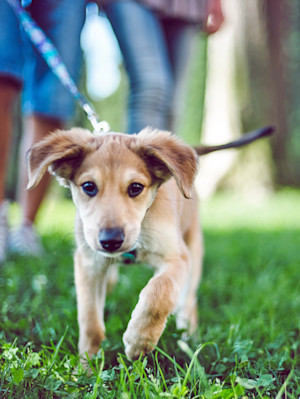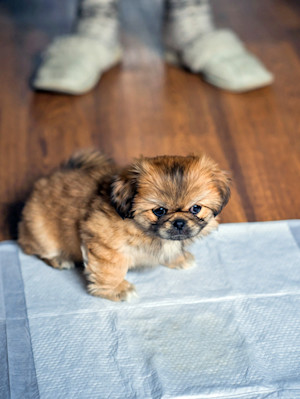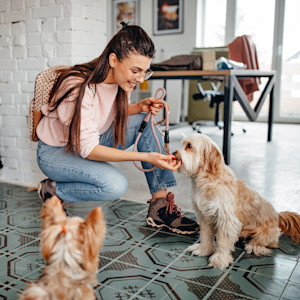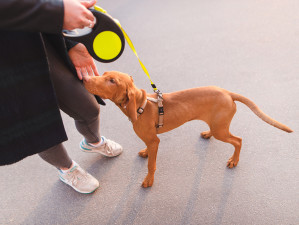When Should a Puppy Be Toilet-Trained?
Follow these careful steps.

Share Article
In This Article:
What Age to Potty Train a Puppy?opens in a new tab Puppy Potty Training Timelineopens in a new tab Puppy Potty Training Tipsopens in a new tab Can You Train Potty on a Verbal Cue?opens in a new tab Frequently Asked Questionsopens in a new tab
Potty training a puppy is a crucial step in their development and your journey as a pet parent. Starting at the right age with effective techniques can make the process smoother for both you and your puppy. Here, we’ll explore when to begin potty training, share proven methods, and provide practical tips to ensure a successful and stress-free experience.

littleKin™ is Kinship’s home just for puppy and kitten parents. Bop over to check out expert advice, new pet tools, and special deals—all curated for your newest family member.
opens in a new tabWhat age should you potty train a puppy?
Potty training your puppy can be a daunting task, it requires patience, time management, and proper treat timing. Potty training a puppy should begin as soon as you bring them home that way you set everyone up for success from the start. A puppy should be at least eight weeks old when you bring them home. If possible, they should be between nine to 12 weeks old, which can be a more ideal time.
Allowing a puppy to spend those weeks with their mother and siblings is crucial to their development. Potty training should begin before your puppy comes home. Make things easier on yourself by prepping ahead of time. Important items to have to set you and your puppy up for success are: a crateopens in a new tab, pee padsopens in a new tab/newspapers, paper towels, u rine cleaneropens in a new tab (without ammonia), a six-foot leash, and a collar, to name a few.
A puppy can hold their pee for about the number of months they are, plus one, so a two-month old puppy can ideally hold themselves for three hours in a perfect setting. If your new puppy will be home alone for more than a few hours without a potty break, it is a helpful idea to set up a potty area for your pet. Set up a small gated area where your puppy can be comfortable on one side with a potty area on the other. This will help your puppy learn that peeing or pooping in one area is allowed, and they do not have free range to go just anywhere.
Puppies and dogs do not typically want to soil an area where they sleep. So, they should naturally stay away from their comfortable area and use the potty area you set up when they are left for longer periods of time. This does not always work for puppies who are coming from deplorable conditions and who were confined to one area and have been eating, sleeping, and peeing in the same space since birth. It is never too late to potty train a puppy or dog. Depending on their age or past life, it just may be more complicated.
Puppy potty training timeline
There is no true expected timeline for puppy training your puppy. It can take anywhere from four months to six months, but some puppies may take a year to be truly potty trained. By being consistent and patient, you can help speed up the process. If you become lackadaisical and allow your puppy to have preventable accidents, then the timeline with take longer. Consistency is key.
Week one
Begin to show your puppy the ropes. Introduce them to their new home, and get them comfortable with the areas where they are allowed. Start a potty schedule and introduce your family members to the puppy rules. Expect accidents; they are bound to happen, so stay calm and patient.
Take your puppy outside every half an hour when they are awake and moving about. Observe what they do right before they pee and poop so that you know when they need to go outside.
Week two
Begin to notice your puppy adjusting to their new environment. You will start to understand their cues and anticipate their behaviors, which will help you know when they need to use the bathroom.
Take your puppy out every 30 to 60 minutes depending on how they are doing with successful potties outside versus accidents.
Week three
The puppy will start to understand some consistent precursors of their schedule (for example, they excited when you pick up a leash). They may be able to anticipate where to go for feeding time, or to run to the front door when you get your shoes.
Week four
Your puppy is getting more comfortable in their environment if you are beginning to see less accidents you can begin to increase the amount of time between potty breaks. Do not get too comfortable with the success; you want to continue to keep up with the schedule to help your puppy learn.
Puppy potty training tips
Follow the potty rule of thumb.
Always take a puppy outside a few minutes after they have eaten or drank a lot, played, or woken up.
When a puppy is sleeping/ alone/ just laying around; a puppy can hold their pee for about as many hours as they are months old, plus one.
Example:
A three-month-old puppy can hold it for four hours.
A four-month old puppy can hold it for five hours.
This rule does not apply when your puppy is out and about playing, eating, or interacting (stick to your schedule during those times).
Don’t scold puppies for accidents.
Scolding a puppy for having accidents is training them to hide from you when they pee or poop. It does not prevent them from going inside; it just teaches them to hide behind a something when they go to the bathroom so their owner can’t see. If your puppy has an accident, and you did not witness them do it, never scold them for something in the past. Instead, just calmly clean it up like nothing happened.
If your puppy has an accident in front of you try to interrupt them (with a calm “eh, eh”) and bring them outside as fast as possible (carrying them may be best), place them down and they may finish going outside be sure to reward them heavily. If they do not go when you get outside head back inside and then go back outside and try again in 15 to 30 minutes.
If you are potty training in an apartment or a large home with a long walk outside, it may be best to carry your puppy outside for potty breaks when starting (especially after drinking/eating, sleeping, or playin)g. This will help avoid any accidents in transit.
Provide a routine for your puppy.
Puppies and children are very similar just like routines help children they also help puppies. Doing your routine in a similar sequence each time will help your puppy anticipate chains of events. Example: Take your puppy out when they first wake up in the morning, then play with them, next feed them breakfast, wait 10 minutes, and take them out again.
Limit unsupervised freedom in your home.
A new puppy or dog should never be left unattended to start. Freedom in your home is something that is earned over time. Puppies are teething, and it is likely that they will get into and chew inappropriate things which can be dangerous. It is very important to puppy-proof your home when you bring home a new dog. Supervising your puppy at all times will also prevent accidents.
If you need to use the bathroom or leave the room for a short time, this is a great time to crate your dog. Using the crate for short periods of time while you leave or while you are around, helps build a positive association with the crate which will help your puppy with crate-training.
Reward them for potty training.
When potty training, you want to use a quick and easy treat that can be given to your puppy right away after they use the pee or poop. You will want to use a soft, high-value treat. You do not want to use something crunchy that takes a long time to chew. While your puppy is going, you can verbally praise them and as soon as they are done, pop the treat in their mouth.
Can you train potty on a verbal cue?
Yes. You can train your dog to go potty on cue to an extent (of course, if they don’t need to poop or pee, and you say the cue, they won’t do it). To start, you are going to begin pairing the word with the action. As your puppy pees, say the words ”go potty” a few times.
Do this over and over for a few weeks. As you are taking your puppy to pee, begin to keep an eye on what they do right before they go. Once you have an idea of the precursor to your puppy peeing, you can then say the cue right before they go.
Find a special potty area.
To train your puppy to go poop or pee right when you take them out, rather than having to walk them around to find the perfect area you will need to designate a potty area. A designated potty area is where you take your puppy when you want them to use the bathroom. Potty breaks and walks are not the same thing. Bring your puppy to the designated area before taking them on a walk.
Only take them on a walk after they have relieved themself in the designated potty area. The walk becomes a natural reward for going poop or pee. This is especially beneficial when you are running late or only have a small window of time to take your dog to the bathroom before having to go somewhere.
FAQs
How long can puppies hold their pee?
Typically puppies can hold their pee for a few hours. You can follow the rule that puppies can hold their pee the number of months they are old, plus one (a three-month old puppy can hold their pee for four hours). A rule of thumb when beginning potty training is: Puppies should always taken out shortly after eating, playing, or sleeping.
What do I do if my puppy won’t go to the bathroom in the snow?
Try clearing a spot for your puppy on the grass by shoveling a space for them. If you have a very young puppy or small dog and know a bad storm is coming, it may be a good idea to have pee pads on hand just in case.
How do you potty train an adult dog?
Potty training an adult dog is very similar to potty training a puppy. The only difference is that adult dogs can hold it for much longer. Adult dogs may have many years of pooping or peeing wherever they want so you will have to rewire this habit. You may be able to increase the time between potty breaks faster as your dog gets the idea. Start taking your adult dog outside to use the potty every hour, as well as after eating, playing, and sleeping.
As they get the idea of what to do continue to increase the time between potty breaks. Using a crate when you can not have your eyes on your dog is the key to success, a dog will typically pee where they sleep.
References
Kalstone, Shirlee. How to Housebreak Your Dog in 7 Days (Revised)opens in a new tab. Bantam, 4 Nov. 2009.
“PawSafe.” Pawsafe.com, 2024, pawsafe.com/blogs/dog-behavior/how-long-does-it-take-to-potty-train-a-puppyopens in a new tab.
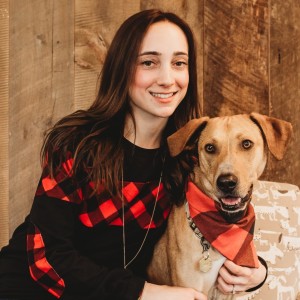
Danielle Vrabel, CPDT-KA
Danielle Vrabel is a dog trainer who earned her CPDT-KA in 2020. Danielle is a proud pet mom of five pets: two dogs, two cats, and a corn snake. Danielle has fostered over 10 dogs and 15 cats/kittens as well as helped train shelter dogs before they are adopted. Both of Danielle’s dogs are pet therapy dogs, where she also volunteers her time helping evaluate future therapy dogs.
Related articles
![Couple walking their new puppy outside in the grass.]() opens in a new tab
opens in a new tabHow to Potty Train a Puppy: From Pee Pad to Outside
And learn how often they have to go outside.
![Small puppy sitting on training pee pad at home.]() opens in a new tab
opens in a new tabHow to Train With a Puppy Pad
First step: patience.
![Woman getting her puppy ready for a walk at home.]() opens in a new tab
opens in a new tabHow to Potty Train a Puppy in an Apartment
By sticking to a schedule, you’ll find it’s very doable.
- opens in a new tab
Why Does My Puppy Pee on My Bed?
And when will it stop?
![A puppy outside on a leash]() opens in a new tab
opens in a new tabHow to Potty Train a New Puppy
Tips you’ll want to pay attention to.


